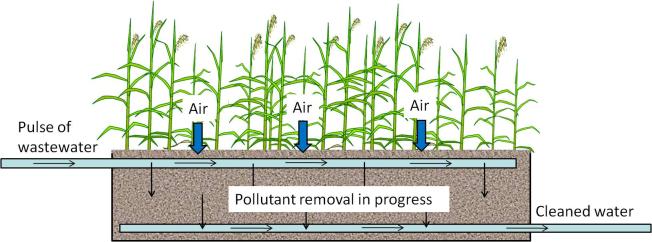How does it work?
The cleaning process
Wastewater is applied in pulses onto a sand or gravel bed, and pollutants are removed as the wastewater moves downward by gravity. This movement creates a suction that draws air into the pores – this helps the bacteria that remove pollutants to breathe and work better.

Different pollutants are removed in different ways
Organic material is eaten by microorganisms living in the bed, or filtered away by the sand or gravel.
Nitrogen (a nutrient) is mainly removed by specialized bacteria in two steps. In the first step, called nitrification, the nitrifying bacteria gain energy by transforming ammonium(NH4+)-nitrogen into nitrate(NO3-)-nitrogen. This is an aerobic process, which means that the bacteria need oxygen to function. In the second step a different group of bacteria use the nitrate instead of oxygen for breathing. This is called denitrification, and the end product is nitrogen gas (N2), which goes off into the air and is thereby removed from the wastewater. Unlike nitrification, denitrification is an anaerobic process, which means that the bacteria work best without oxygen. Nitrogen is also used by microorganisms and plants as building blocks for their own growth, but it is still unknown how important plants are for the total removal of nitrogen in VF CWs.
Bacteria from human intestines (such as Escherichia coli) are filtered away or eaten by other microorganisms in the bed.
Find out what we did under "Experiments and analyses" in the left menue.
Responsible for this page:
Director of undergraduate studies Biology
Last updated:
05/23/11
